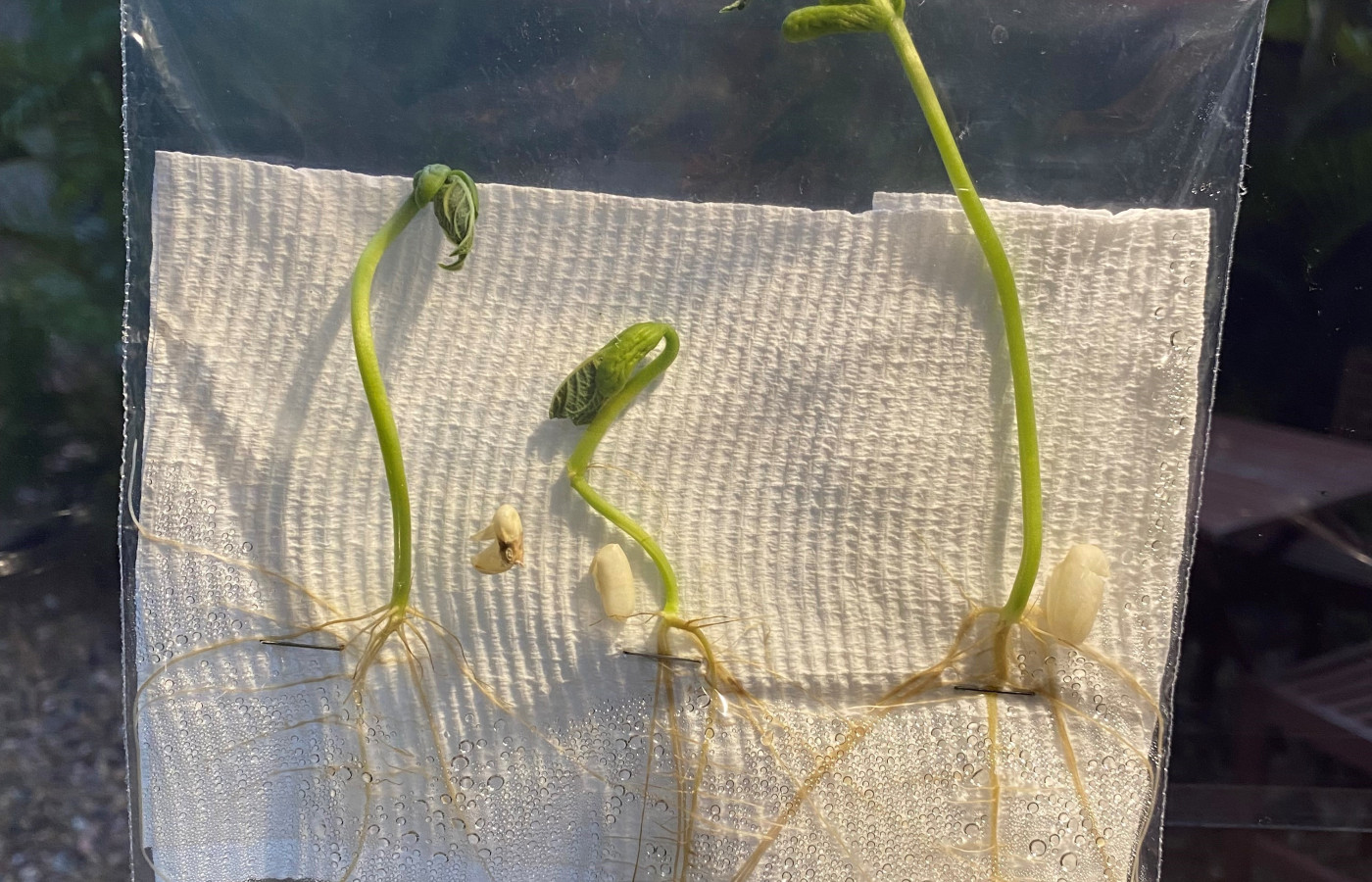Growing beanstalks

Growing beanstalks
Growing beans in a clear plastic bag
Materials Required
- Bean seeds
- Paper towel or cotton wool balls
- Zip lock clear plastic bag, sandwich size
- Clean water
- Stapler
- Sticky tape
Dried beans from supermarket can be used as an alternative, Jars can be used as an alternative to plastic bags, Ruler, Pencils, Paper, Camera, Magnifying glass
Play experience profile
-
Ages:
-
Min Playtime15 - 30 Minutes
-
Skills
-
Energy LevelQuiet Play
-
Messiness Rating
-
EYLF Outcomes
Play Experience Preparation
Choose a location for this activity. A kitchen sink and access to clean water is a good location.Experience Steps
- Slightly wet two sheets of paper towel or a handful of cotton balls.
- Fold the damp sheets of paper towel so that they fit flat inside the zip lock bag.
- With the plastic bag on a flat surface, place three bean seeds halfway (in the middle) of the plastic bag.
- Make sure that you space the bean seeds apart to provide enough space for each plant to grow.
- Place a staple under each bean seed to secure in place.
- Close the plastic bag, this creates a mini greenhouse effect.
- Stick bag to the window with tape with the seeds facing inside.
- As the bean seeds begin to germinate, check that the paper towel remains damp, not too wet.
- When the plant leaves start to grow, leave the top of the plastic bag open.
- Set a time each day to observe any changes in the bean seeds.

What to talk about, or questions to ask during the experience
- Introduce the experiment, "today, we are going to make a mini greenhouse to grow some beans and over 7 days watch if anything changes".
- Ask questions to predict what you might see happen?
- Discuss what is needed for seeds to germinate? Water, sunlight, seed.
- Each day, remind the child to check to see if there are any changes from the previous day. Ask what has changed?
- Count the number of leaves, roots, and size of the plants.
- Talk about finding ways that you can grow food and learning about where fresh food comes from.
- Visit the local library and ask picture storybooks on plants and seeds. An example is the Eric Carle book, ‘The Tiny Seed’.
Build on this...
- When the bean plants outgrow your plastic bag, you could replant into a pot or garden bed.
- When the bean plants outgrow your bag, the adult can dissect the parts of the plant and examine with a magnifying glass.
- You could compare this to a weed that you remove from your own garden? Are there any differences?
- You can record the growth of the bean seeds by drawing a picture each day or taking a photo.
- Documenting the growth will assist to recall what, when and how the bean seed changed throughout the activity/experience.
- You can draw up a table and using a ruler measure the height of the plant. Also, you can record the number of roots and leaves daily.
- If the beans do not germinate, research what might have happened using digital technology and try again.
- Locate a community garden in your local community and organise a visit to provide a ‘hands-on’ experience of where food is grown.
- Research native species of plants that grow in your community. When you go for a walk or to the local park, collect seed pods with your child and have a go at germinating them at home.
WHO guidelines for physical activity and sedentary behaviour
Provide evidence-based public health recommendations for children, adolescents and adults on physical activity.
Learn more
Provide evidence-based public health recommendations for children, adolescents and adults on physical activity. Learn more
Play musical statues after the activity. Play music and have the children dance and when the music stops, the children have to be still like statues. You could relate it to the activity by asking them to be still like a beanstalk.
EYLF Outcomes
The Early Years Learning Framework has been designed for use by early childhood educators working in partnership with families, children’s first and most influential educators.
View PDF
The Early Years Learning Framework has been designed for use by early childhood educators working in partnership with families, children’s first and most influential educators. View PDF
- Children develop a range of skills and processes such as problem solving, inquiry, experimentation, hypothesising, researching and investigating
- Children resource their own learning through connecting with people, place, technologies and natural and processed materials
EYLF Principle
Principle 1: Secure, respectful and reciprocal relationships. Through a widening network of secure relationships, children develop confidence and feel respected and valued.
EYLF Practice
Practice: Learning through play. Play can expand children’s thinking and enhance their desire to know and to learn. In these ways play can promote positive dispositions towards learning. Children’s immersion in their play illustrates how play enables them to simply enjoy being.
https://garden.lovetoknow.com/garden-basics/life-cycle-bean-plant
https://www.betterhealth.vic.gov.au/health/healthyliving/gardening-for-children
http://anpsa.org.au/seed.html
https://www.abc.net.au/gardening/factsheets/seed-saving-secrets/13239606
Author:


